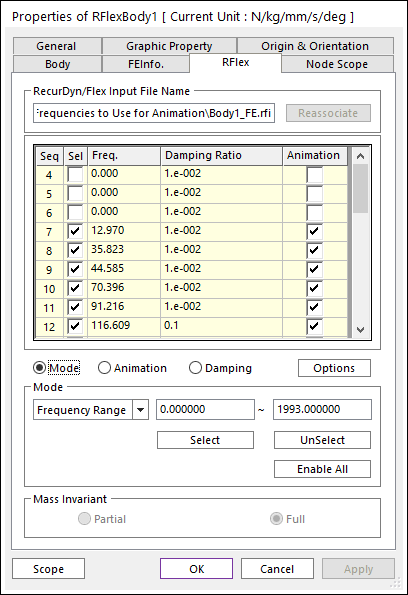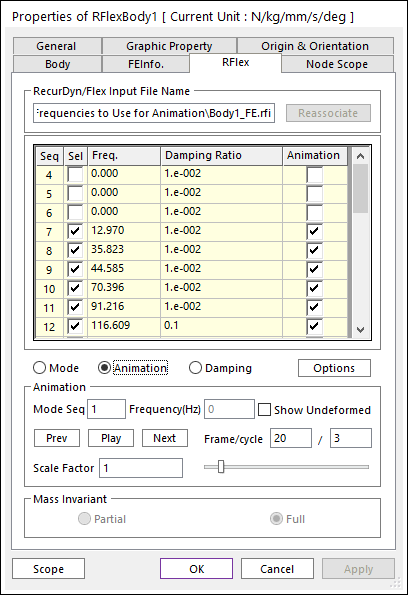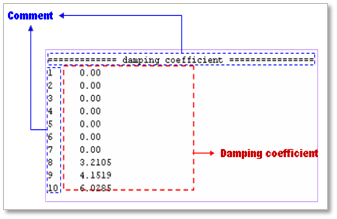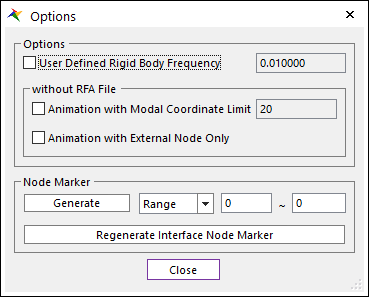10.5.2.2. RFlex Page
After importing a Flexible body as Filename.rfi file, you can change the properties of its body in the following window.

Figure 10.92 RFLEX tab of Properties of RFlexbody dialog box [Mode]

Figure 10.93 RFLEX tab of Properties of RFlexbody dialog box [Animation]

Figure 10.94 RFLEX tab of Properties of RFlexbody dialog box [Damping]
In the RecurDyn/RFlex, the following modal information is displayed.
Frequency: Frequency of each mode.
Coord: Initial condition for modal coordinate
Velocity: Initial condition for modal velocity
Mode: You can select mode by Mode Range or Frequency Range.
Mode Range: select mode by its sequence.
Frequency Range: select mode by its frequency
Animation: You can see each Mode shape as animation.
Mode Seq: Sequence of the current mode.
Frame/cycle: Animation frame and Cycle.
Frequency: Frequency of the current mode
Prev: The previous mode
Play: Play animation of its mode
Next: The next mode
Scale Factor: Scale factor of mode shape.
Show Undeformed: Show mode shape with the undeformed state.
Damping: You can modify damping values.
Damping Type: Determine calculation type
Damping ratio: \(\zeta\)
Damping coefficient: \(c=\zeta\cdot c_c\)
Critical damping coefficient: \(c_c=2m\omega_n=4\pi mf\)
Damping coefficient: direct value
Stiffness proportional ratio [%]: \(\alpha\)
Damping coefficient: \(c=0.01\alpha k=0.01\alpha\omega^2\)
Default: Set Damping coefficient by Critical damping ratio
\(\begin{aligned} &0<f<100\text{(Hz)}\to\zeta\text{(Damping ratio)}=0.01 \\ &100\leq f<1000\text{(Hz)}\to\zeta\text{(Damping ratio)}=0.1 \\ &1000\text{(Hz)}\leq f\to\zeta\text{(Damping ratio)}=1 \end{aligned}\)
Mode Range: Select mode by its sequence
Frequency Range: Select mode by its frequency
Import: import damping coefficients of all modes
File format (*.fdc)
The total number of modes should be equal.The first line is comment.The second column should have damping coefficients of all modes.
Reassociation: If the RecurDyn cannot find an RFI file when you open a model, this function is activated and you can reassociate the RFI file again. Also, this function is inactivated after the RFI file is connected.
Mass Invariant option
When the Depends on Body Setting is selected in the Flexibility/RFlex tab is selected, then this option can be selectable. The default is Full.
If the Depends on Body Setting in Flexibility/RFlex tab and Partial option is selected, then the Invariant Variables N4 (\({{\mathbf{\zeta }}_{6}}\)) and N6 (\({{\mathbf{\zeta }}_{8}}\)) related in the Mass Matrix of a RFlex body are not computed for solving speed improvement.
If the Depends on Body Setting in Flexibility/RFlex tab and Full option is selected, then the all Invariant Variables are used for computing the Mass Matrix.
Note
10.5.2.2.1. Options

Figure 10.95 Options dialog box of RFlex body
User Defined Rigid Body Frequency: The user can define Rigid Body Frequency.
Without RFA File: The user can use these options to improve animation speed without RFA file.
Animation with Modal Coordinate Limit
If this option is checked, the user can input a modal coordinate limit. This value limit no. of used mode to calculate deformation of RFlex Body.
If the option is not check, Deformation of RFlex body is calculated by using all mode. (This option is default.)
Animation with External Node Only
If the option is checked, Deformation of RFlex body is calculated about external nodes only.
If the option is not check, deformation of RFlex body is calculated about all nodes. (This option is default.)
Marker Generation: This option helps you to generate node markers at nodes. Two methods are supplied. The one is that you can generate node markers in a range. The second is that you can generate node markers at the selected node ID. This marker can be used to connect joint or force on a flexible body. If interface nodes exist, you can regenerate the marker of these nodes on flexible body.
Regeneration Interface Node Marker: The user can regenerate markers on interface nodes. Maximum number of creating markers located on the Interface Nodes can be defined in RFlex tab in the Flexibility/RFlex tab.